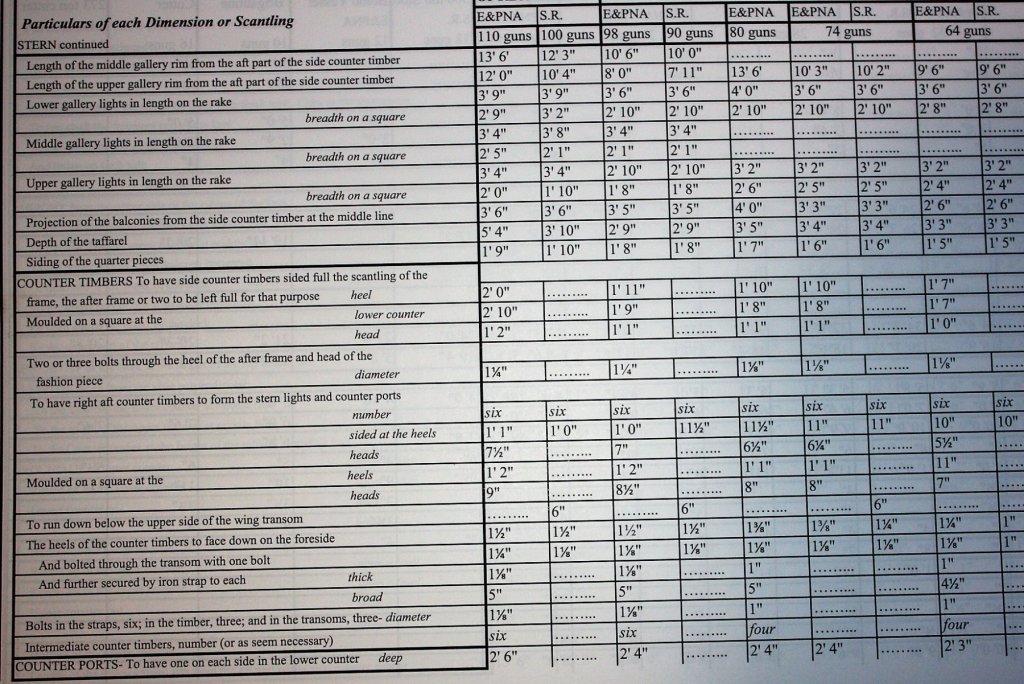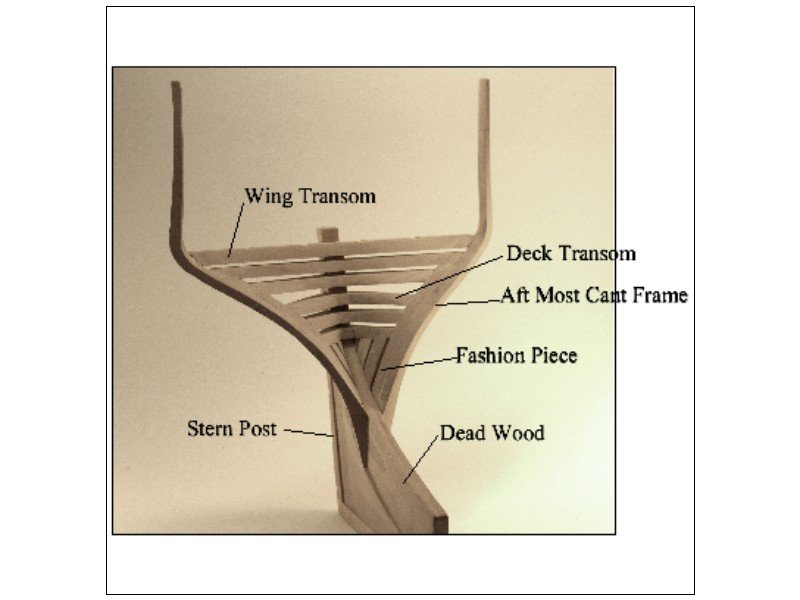-
Posts
8,149 -
Joined
-
Last visited
Content Type
Profiles
Forums
Gallery
Events
Everything posted by allanyed
-

Split Brass Ring Frustrations
allanyed replied to David Lester's topic in Masting, rigging and sails
I believe all the references to soldering are for silver soldering, not soft soldering. Be sure the ends are clean. Steel wool or a quick swipe or two with a jewelers file or even Silver solder paste most often has flux and does not need to have a separate step to put flux on the part. Allan -

Stern timber scantlings
allanyed replied to Mark P's topic in Building, Framing, Planking and plating a ships hull and deck
Mark The following is a page from Scantlings of Royal Navy Ships that may help. I assume you were speaking of the counter timbers. Note that the Shipbuilder's Repository (1788) does not have all the dimensions Steel shows. Thanks for the plug Wayne. Allan -
Bill I have been working on and off on drawings of Elizabeth 1706 for my next big project. Alas, with work and other adventures it will likely be quite a while before making saw dust but at least I have been able to find some time to work on the drawings. As I study the drawings of Elizabeth 1706 and Hampton Court 1709 that I have found, I would love to study the logs as well. Are they prior to her 1737 rebuild to the 1733 Establishment? Where can these be acquired? Any information you can share would be greatly appreciated and hopefully I can reciprocate in some way. Thanks Allan
- 5 replies
-
- cloudesley shovell
- longitude
-
(and 4 more)
Tagged with:
-
Stephen The smallest carronades I could find in a quick search in Caruana' English Sea Ordinance were 12 pounders which in 1815 were 26 inches long. At your scale, if my math is right, this would be about 0.30 inches long, or half the size of the smallest in from Bluejacket. The longest 12 pounder I could find were in the 1700s and as much as 30 inches long You mention a schooner brig (hermaphrodite brig ). Do you have a specific vessel in mind? That might help determine the armament. Allan
-
Welcome Doc There is no better place to get a LOT of tips on building a better model ship than here. Very happy to see another scratch builder come on board. Allan
-
Hand made sticks for various shapes other than flat is a good way to go. Dowel rod, home made shapes, bow shaped etc. Allan
- 12 replies
-
- sanding sticks
- files
-
(and 1 more)
Tagged with:
-
Bob, 15 minutes per completed internally stopped block? You work fast. Took me about 50 to 60 hours for the last schooner model to make all the sizes with reasonable quality. Allan
-
Steven, Surely most officers came from families of "higher status" in the then current hierarchy, but there were some that worked their way to the quarterdeck from before the mast. This following site would take a LOT of time to dig into but maybe take a look at http://www.nationalarchives.gov.uk/help-with-your-research/research-guides/royal-navy-officers-service-records-1756-1931/ Allan
-
Welcome Alain Having recently vacationed in the south of France, my wife and I have decided if we ever wish to live somewhere other than our current home in Florida, we are heading to Nice or Provence. You are fortunate to live in such a lovely part of the world! Allan
-
Richard I am curious as I cannot find anything of an HMS Syren circa 1802. From what I did find, Syren of 1782 was in sea service up until she was put to harbor service from 1805 and broken up in 1822. HMS Siren was to have been a 32-gun fifth-rate, ordered in 1805 but was cancelled in 1806. If Syren 1782 went through refitting after the 1790s she possibly could have had stern davits installed. I suspect the 18 foot cutter (clinker built) would have been the boat hung from a set of the davits. The earlier davits were not capable of handling larger boats so the launch and pinnace may not have been hung. I remember in previous research that 36 gun frigates commonly had only stern davits, thus it may be OK to conclude that there would only be stern davits for the cutter and no quarter davits. Allan
-
Richard, I quote from W.E. Mays. In the 1790s an additional system was introduced. Davits were for the first time fitted on each quarter of ships for hoisting two of the lighter boats, usually cutters. ........Boats hoisted at davits came often to be called quarter-boats. According to Admiral of the Fleet Sir Thomas Byam Martin this innovation had not yet appeared in 1790. The earliest example that I have been able to trace was in an order of 1798 that a number of 64-gun ships and some smaller, which were being fitted as transports, should each have a launch, with a jolly boat to stow inside it on the spar-deck, and two 25 foot cutters which were to hang at davits on each quarter. Fixed stern davits were introduced in the 1790s. these were used to handle a sea-boat, most commonly the smallest cutter called the jollyboat. So, Syren of 1782 would not have davits, as-built. That is not to say they were not added at a later date. As to being a fountain of information, I just happen to be lucky enough to have collected several dozen good books. Allan
-
Richard According to W. E. May a 32 in about 1781 had a 23/24 foot launch, 30 foot pinnace, and 18 foot cutter. Cutter replace pinnaces in many cases starting about 1782/83. Lavery states that yawls were used in place of cutters earlier on. Neither mentions a 22 foot cutter. so choose your poison. Allan
-

Agamemnon and Vanguard twin ships?
allanyed replied to semorebutts's topic in Nautical/Naval History
Nice handle Semore. Share your name please :>) I looked at the RMG collections and the Aggy (64 guns) was 1781 out of Bucklers Hard and Vanguard (70 guns) was 1745 built to the 1745 Establishment and then another in 1787, a 74 (out of Deptford yard) and then again in 1835 (80 guns out of Portsmouth.) It is not likely there were any similarities to Aggy, certainly not sister ships. Maybe I missed one somewhere in between. There are a couple drawings of Vanguard dated 1748 built to the 1745 Establishment but not sure if it is the same ship as from 1745 as the drawing is dated 1745. Allan -
Mrmdpc Glad to meet you. What is your name? Hope this helps. It is from Chapelles American Fishing Schooners, page 381. Allan
-
I am thoroughly enjoying the Thomas Kydd series. I have it on Kindle so can get definitions as there are a lot of archaic words used. Not absolutely needed though and they have been fun reads from Thomas being pressed on board to making Post Captain on a frigate through the first 8 books or so and quite a few more to go. Allan
-

Greetings, from Seattle Washington
allanyed replied to Estoy_Listo's topic in New member Introductions
Welcome aboard Mark With all the rainy days in your neck of the woods, you will likely have more modeling time than most! Cheers Allan -
Welcome Shaunzy Your project will indeed take perseverance but it will keep you out of the casinos as you won't have the time! Better to have money for tools than the tables :>) Allan
-
J There would be several different size lines for the standing rigging. The fore, main and mizzen back stays and fore stays are different as are the shrouds to name a few. For the model, I would not go crazy, but if you use 3 or perhaps 4 sizes, it will probably be enough to give the impression of different sizes throughout and will look far more realistic than using one size for everything. Allan
-

Newbie needs help
allanyed replied to Louie M's topic in Building, Framing, Planking and plating a ships hull and deck
Lou Fancy rail and fancy cap are new ones for me. Maybe they mean the cap rail which is just that, the rail that caps the top of the frames. The fashion piece - On the ship and on a framed model these are the aft most hull half frames to which the transoms are mated. Allan
About us
Modelshipworld - Advancing Ship Modeling through Research
SSL Secured
Your security is important for us so this Website is SSL-Secured
NRG Mailing Address
Nautical Research Guild
237 South Lincoln Street
Westmont IL, 60559-1917
Model Ship World ® and the MSW logo are Registered Trademarks, and belong to the Nautical Research Guild (United States Patent and Trademark Office: No. 6,929,264 & No. 6,929,274, registered Dec. 20, 2022)
Helpful Links
About the NRG
If you enjoy building ship models that are historically accurate as well as beautiful, then The Nautical Research Guild (NRG) is just right for you.
The Guild is a non-profit educational organization whose mission is to “Advance Ship Modeling Through Research”. We provide support to our members in their efforts to raise the quality of their model ships.
The Nautical Research Guild has published our world-renowned quarterly magazine, The Nautical Research Journal, since 1955. The pages of the Journal are full of articles by accomplished ship modelers who show you how they create those exquisite details on their models, and by maritime historians who show you the correct details to build. The Journal is available in both print and digital editions. Go to the NRG web site (www.thenrg.org) to download a complimentary digital copy of the Journal. The NRG also publishes plan sets, books and compilations of back issues of the Journal and the former Ships in Scale and Model Ship Builder magazines.




